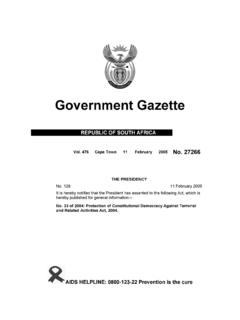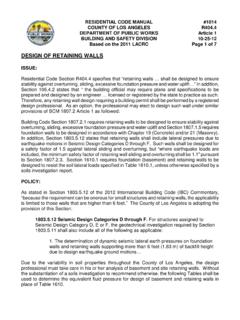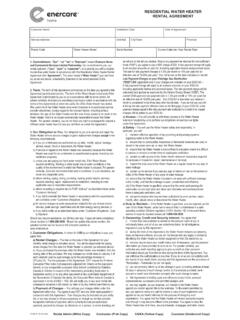Transcription of Identification and Verification
1 Financial Intelligence Centre Guidance Note 3 AGuidance foraccountable institutionson clientidentification andverification and related mattersPREFACEM oney laundering has been criminalised in section 4 of the Prevention ofOrganised Crime Act, money laundering offence may be describedas the performing of any act that may result in concealing the nature of theproceeds of crime or of enabling a person to avoid prosecution or in thediminishing of the proceeds of from criminalising the activities constituting money laundering, SouthAfrican law also contains a number of control measures aimed at facilitatingthe detection and investigation of money laundering. These controlmeasures, as contained in the Financial Intelligence Centre Act, 2001 (the FIC Act ), are based on three basic principles of money laundering detectionand investigation, that: intermediaries in the financial system must know with whom they aredoing business; the paper trail of transactions through the financial system must bepreserved.
2 Possible money laundering transactions must be brought to theattention of investigating control measures introduced by the FIC Act include requirementsforinstitutions to establish and verify the identities of their clients, to keep certainrecords, to report certain information and to implement measures that willassist them in complying with the FIC Guidance Note 3 Afor accountable institutions on customeridentification and Verification and related matters2 The majority of obligations under the FIC Act apply to accountableinstitutions . These areinstitutions that fall within any one of the categories ofinstitutions listed in Schedule 1 to the FIC FIC Act also established the Financial Intelligence Centre ( the Centre )as the agency responsible for the collection, analysis and disclosure ofinformation to assist in the detection, prevention and deterrence of moneylaundering in South Africa.
3 In addition, section 4(c) of the FIC Act empowersthe Centre to provide guidance in relation to a number of matters concerningcompliance with theobligations of the FIC of this Guidance NoteThis Guidance Note applies to theallaccountable institutions that are referredto in Schedule 1 to the FIC guidanceprovided in this Guidance Noteis provided as generalinformation Guidance Note does not provide legal advice and is notintended to replace the FIC Act or the Money Laundering Control Regulations( the Regulations ) issued under the FIC Act in December Guidance Note is published by the Centreunder section 4(c) of the FICAct to assist accountable institutions and the relevant supervisory bodies withthe practical application of certain client Identification and client verificationrequirements of the FIC Act. Some of the terminology used in this GuidanceNote is explained in a glossary attached as an addendum to provided by the Centre is the only form of guidance formallyrecognised in terms of the FIC Act and the Regulations issued under by the Centre is authoritative in institution mustapplyguidance issued by the Centre.
4 Ordemonstrate an equivalent level of compliance with the relevant obligationsunder the FIC is important to note that enforcement action mayFIC Guidance Note 3 Afor accountable institutions on customeridentification and Verification and related matters3emanateas a result of non-compliance with the FIC Actwhere anaccountable institute does not follow guidance issued by the Centre andcannot demonstrate compliance with the legal obligation to which theguidance emanating from industry associations or other organisations,therefore, in the Centre s view, does not have a bearing on compliance withthe obligations imposed by the FIC Act or interpretation of its LAUNDERING AND TERRORIST FINANCING POLICIESAND managementapproval of anaccountableinstitution santi-money laundering and terrorist financing policiesand proceduresBoard of directors /senior management sapproval of an accountableinstitution s own internal policies and procedures to address moneylaundering and terrorist financing is critical if an accountable institutionwishes to be considered serious about its appreciation of, andwillingness to.
5 Mitigate money laundering and terrorist-financing risks inits daily Centre therefore expects that the internal anti-money launderingand terrorist financing policies and procedures ofan accountableinstitutionshould be adopted and approved by the board of directors ofthataccountable will also ensure that the board/senior managementof a particularaccountable institutiontakes ownership of its obligations in terms of theFIC Act. The criminaland administrativepenalties for failure to complywith the obligationsofthe FIC Actare severe, and directors/seniormanagementmay be held personally Guidance Note 3 Afor accountable institutions on customeridentification and Verification and related of Guidance Note 1 in respect of a risk-basedapproachAlthough the FIC Act and the Regulations do not expressly makereference to a risk-based approach, thesemeasures allow limitedscope to apply a risk-based approach to the Verification of certain clientparticulars.
6 This issue is covered in Guidance Note 1 issued by theCentre in April Note 1 indicates that application of a risk-based approach tothe Verification of the relevant particulars implies thatan accountableinstitutioncan accurately assess the risk involved. It also implies thatan accountable institutioncan take an informed decision on the basisof its risk assessment as to theappropriate methods and levels ofverification that should be applied in a given Note 1 further states thatthe assessment of these riskfactors should best be done by means of a systematic approach todetermine different risk classes and to identify criteria tocharacteriseclients and products. In order to achieve this,an accountable institutionwould need to document and make use of a risk framework. Such arisk framework should preferably form part of theaccountableinstitution sinternal policies and procedures to address moneylaundering and terrorist financing referred to in paragraph 1, indicators to be used to differentiate between clientsThe FIC Act and the Regulations require thataccountable institutionsidentify all clients with whom they do business unless an exemptionapplies in a given institutions, however, arenot required to follow a one size fits all approach in the methods thatFIC Guidance Note 3 Afor accountable institutions on customeridentification and Verification and related matters5they use and the levels of Verification that they apply to all is imperative that the money laundering risk in any givencircumstance be determined on a holistic basis.
7 In other words, theultimate risk rating accorded to a particular business relationshiportransaction must be a function of all factors that may be relevant to thecombination of a particular client profile, product type and combination of the following factors may be applied to differentiatebetween high risk, medium risk and low risk clients: product type; business activity; client attributes, for example, whether the client is on the UnitedNations list, duration of client relationship withtheaccountableinstitution, etc; source of funds; jurisdiction of client; transaction value; type of is not an exhaustive refer to Guidance Note 1 forfurther particulars on the implementation of a risk-based procedures for high-risk clientsIn terms of Regulation 21 of the Regulations,an accountable institutionmust obtain certain additional information whenever this informationmay reasonably be required to identify: a business relationship or single transaction that poses aparticularly high risk of facilitating money laundering activities; or the proceeds of unlawful activity or money laundering Guidance Note 3 Afor accountable institutions on customeridentification and Verification and related matters6In most instances it is a combination of factors, not any onefactor thatwill lead to a conclusion that a transaction or relationship poses amoney laundering risk.
8 Allcircumstances surrounding a businessrelationship or transaction should be risk factors referred to in paragraph 3, above, may be helpful toaccountable institutions in assessing when additional information maybe required in order to enhance the institution s profile of a particularclient. In addition there are a number of further factors that mayindicate that abusiness relationship or single transaction poses a highrisk of facilitating money laundering activities, or the presence of theproceeds of unlawful activity. The following examples of such activitiesare applicable to the banking sectorbut can also be useful for non-banking institutions: a client appears to have accounts with several banks in onegeographical area; a client makes cash deposits to a general account of a foreigncorrespondent bank; a client wishes to have credit and debit cards sent todestinations other than his or her address; a client has numerous accounts and makes or receives cashdeposits in each of them amounting to a large aggregatedamount; a client frequently exchanges currencies; a client wishes to have unusual access to safe deposit facilities; a client s accounts show virtually no normal business relatedactivities, but are used to receive or disburse large sums.
9 A client has accounts that have a large volume of deposits inbank cheques, postal orders or electronic funds transfers; a client is reluctant to provide complete information regardingthe client s activities;FIC Guidance Note 3 Afor accountable institutions on customeridentification and Verification and related matters7 a client s financial statementsdiffer noticeably from those ofsimilar businesses; a business client s representatives avoid contact with thebranch; a client s deposits to, or withdrawals from, a corporate accountare primarily in cash, rather than in the form of debit and creditnormally associated with commercial operations; a client maintains a number of trustee accounts or client sub-accounts; a client makes a large volume of seemingly unrelated depositsto several accounts and frequently transfers a major portion ofthe balances toa single account at the same bank or elsewhere.
10 A client makes a large volume of cash deposits from a businessthat is not normally cash intensive; a small business in one location makes deposits on the sameday at different branches; there is a remarkable transaction volume and a significantchange in a client s account balance; a client s accounts show substantial increase in deposits of cashor negotiable instruments by a company offering professionaladvisory services; a client s accounts show a suddenand inconsistent change intransactions or to above may be legitimate features of certaincategories of businesses, or may make business sense if viewed in thecontext of the client s business activities. However, it isequallypossible that these features would be unexpected in relation to certaincategories of businesses, or would have no apparent businesspurpose, given a particular client s business activities.



![INDEX [www.fic.gov.za]](/cache/preview/9/6/5/3/1/9/a/2/thumb-965319a288f9a0d52c473a2b2978aa6d.jpg)










